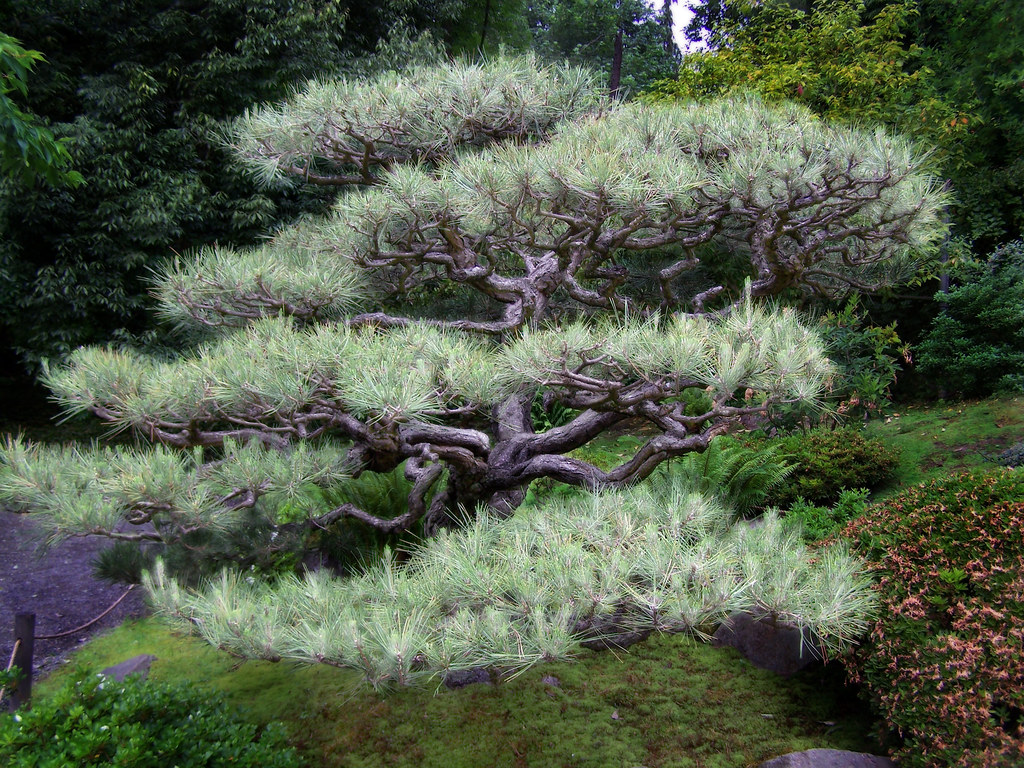The Story of the Century Old Black Pine Tree

The century old pine gifted by Richard Yamasaki, who dedicated over 30 years to Seattle Japanese Garden.
Around the early 1920s, a gift arrived at the South Seattle home of landscaper Masagoro Yamasaki: a young Japanese black pine Pinus thumbergii. After planting it in his front yard, Mr. Yamasaki began training it in the Japanese style. As the pine grew, so did his two sons, who began to take part in its care as apprentices to their father’s gardening business. Together, they maintained the cycle of fall pruning and spring candling of this pine, year after year. Then, the forced relocation of Japanese-Americans during World War II began.
“No matter how beautifully a garden is designed,” Iida remarked, “all is lost without proper and timely care.”
The elder Yamasaki was relocated immediately. Sometime later, his elder son Richard was sent away to another location. Masagoro Yamasaki would never return to his Seattle residence.
In 1945, as the Yamasaki family began to rebuild their disrupted lives, care for the neglected pine resumed. Richard, along with his new wife Fumiko, had returned to his childhood home.
A fateful turning point came for the tree and its second-generation owner in 1959, when the Yamasaki Landscape Company was selected as one of the contractors for the construction of Seattle Japanese Garden in the Washington Park Arboretum. The project brought Richard Yamasaki into contact with the garden’s renowned designer, Professor Juki Iida, who’d come from Japan to supervise the installation. The early relationship was awkward, with each man still suffering from the lasting prejudices that World War II had instilled between Japanese nationals and Japanese-Americans. Eventually, in showing his eagerness to learn, Yamasaki built a bridge over their divide and won over Professor Iida.
"He taught us to take time, to ‘sit on the stone’ and observe before we acted"
With Mr. Iida as his sensei, Mr. Yamasaki greatly refined his art of pruning pines, which he continued to practice in the years following garden construction. As Jim Thomas, former Senior Gardener of the Seattle Japanese Garden writes, “Each visit to the garden reinforced the landscaping lessons he had learned from Professor Iida: the importance of the void or space between the objects, the contrast of form and mass, and the artful use and placement of stone.”
At the end of their 15 year mentorship, in the mid-1970s, Mr. Iida imparted one last lesson to his dedicated student and caretaker of the only Japanese Garden he’d designed in North America. This was the vital importance of consistent maintenance. “No matter how beautifully a garden is designed,” Iida remarked, “all is lost without proper and timely care.”
The pine in the front yard of the South Seattle home continuously received proper and timely care by its second generation owner. Towards the end of his career, the maintenance of the Japanese Garden was turned over from the University of Washington to the Seattle Parks Department. Mr. Yamasaki, now assuming the role of sensei, taught all there was to Japanese Garden care to the gardeners like Thomas who were assigned to this duty. Thomas recalls, “He taught us to take time, to ‘sit on the stone’ and observe before we acted and then, once we undertook something, to follow it through to the end—and be consistent.”
By the time Richard Yamasaki was ready to retire in 1989, the once-young tree in his front yard had developed into a magnificent specimen, reaching over seven-feet-tall, and eight-feet-wide, with a trunk fourteen inches in diameter. As the time devoted to carrying out the vision his sensei had for the Seattle Japanese Garden neared its end, Mr. Yamasaki decided it was time for another goodbye. The pine tree left its home and caretaker of sixty years to become an extraordinary gift: the new, oldest tree in Seattle Japanese Garden.
Richard Yamasaki passed away in February 2008. Now over 100 years old, the transferred pine has fully integrated into its not-so-new home, and is carefully and consistently maintained by gardeners and consultants who call Mr. Yamasaki their sensei. Its presence enhances the north hill by repeating the rounded form of the smaller pines that surround it.
The venerable black pine is a living witness to history. It is also a tribute to the man who came across the Pacific to impart his Japanese Garden design wisdom, and the man who, over many decades, dedicated himself to executing on it.
Rumi Tsuchihashi is the Stewardship and Events Coordinator at Seattle Japanese Garden, and the blog editor.
Jim Thomas, former Senior Gardener of Seattle Japanese Garden, contributed the referenced article The New, Old Pine Tree to the Arboretum Bulletin, Vol. 57, Spring 1994.
